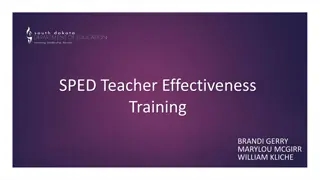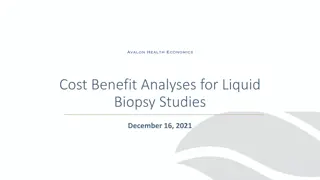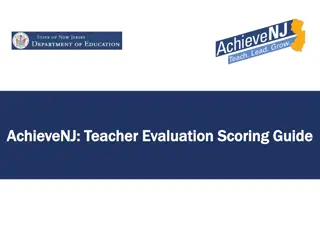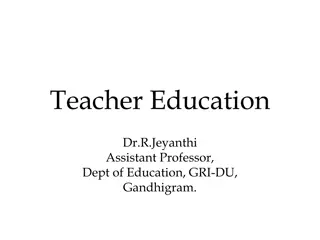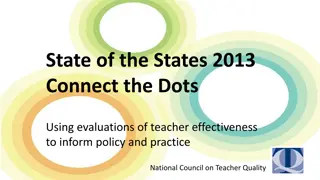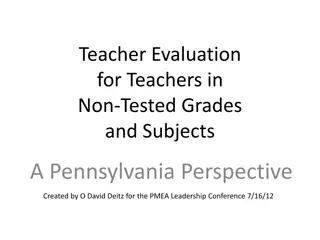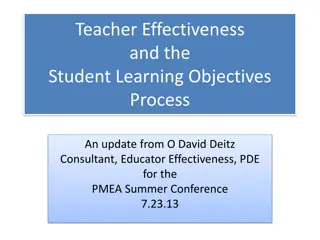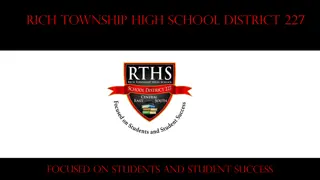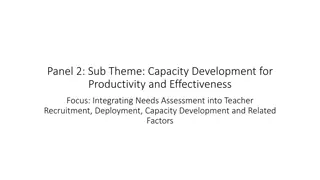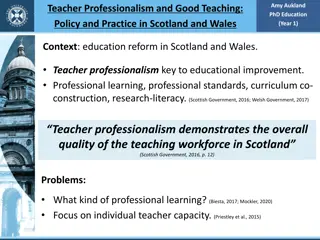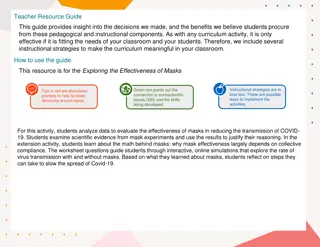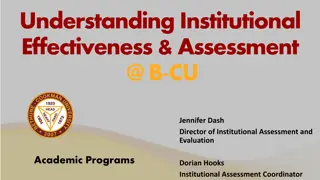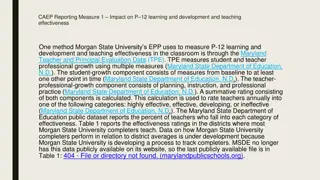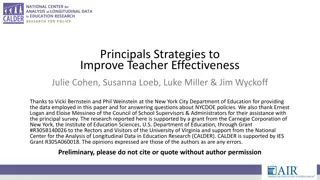Enhancing Teacher Effectiveness Project Overview
The Teacher Effectiveness Project aims to create an integrated teacher evaluation and development system to support professional growth and student success in NYC/NY State. Through teacher assessment, development, and strategic decision-making, the project seeks to recognize and retain outstanding teachers while helping all educators reach their full potential. Teacher input is critical in shaping this collaborative process for fair and transparent evaluation. The pilot initiative involves testing and refining the system at select schools before full implementation across all schools.
Download Presentation

Please find below an Image/Link to download the presentation.
The content on the website is provided AS IS for your information and personal use only. It may not be sold, licensed, or shared on other websites without obtaining consent from the author. Download presentation by click this link. If you encounter any issues during the download, it is possible that the publisher has removed the file from their server.
E N D
Presentation Transcript
Teacher Effectiveness Project Teacher Effectiveness Project
The Teacher Effectiveness Action Research Project The Teacher Effectiveness Action Research Project Create an integrated development and evaluation system by: DEVELOP 1. Assessing each teacher s performance level fairly and accurately. Teacher Effectiveness 2. Designing effective development to help each teacher grow. 3. Making strategic retention, promotion and dismissal decisions based on teacher performance. EVALUATE Both the evaluation and development processes are iterative. Evaluation is not always formal or summative, and development is an on-going cycle for all teachers that is individualized by evaluation information and aims to support professional growth. 2
Overview of the Pilot Overview of the Pilot What: What: An initiative to design, test and roll out a new, integrated teacher evaluation and development system that will inform NYC/NY State approach in future years. Our main goals are to identify, recognize and retain great teachers and help all teachers reach their full potential. Why: Why: Teachers matter more than any other school factor in student success. A better teacher evaluation and development system will give teachers the knowledge and support they need to grow as professionals and help schools build stronger instructional teams. How: How: Teachers and principals at a set of pilot schools will field-test the new system and offer ongoing feedback that shapes its design. When: When: This year, we will test the model and its tools to see what works and what doesn t. Next year, we will begin putting the information to use, for example by finding ways to recognize top teachers. Eventually the system will be rolled out to all schools. 3
Teachers make all the difference! Teachers make all the difference! If we re going to give all students great teachers, we need to better understand each teacher s strengths and weaknesses and how we can help them reach their peak. To do this, we have to be able to assess each teacher s effectiveness in the classroom fairly and accurately. An improved evaluation and development system will allow us to give teachers better feedback and support. NY State legislation will soon require use of a 4 point teacher rating system and inclusion of student growth measures in teacher evaluation. By piloting this work now, we have an opportunity to co-design a system that is fair, transparent and rigorous.
Teacher input is critical Teacher input is critical This is a collaborative process. We know an evaluation system can t work unless it actually helps teachers do their jobs better. Teachers will be involved in developing the system through surveys, feedback opportunities, and participation in cross- school working groups; our approach will evolve based on their input. This is our chance to shape the system! It s essential that the pilot reflect the needs of our unique circumstances and structures at Cascades and other transfer high schools. 5
When is teacher development provided and When is teacher development provided and performance evaluated? performance evaluated? The model is based around three explicit conversations between a teacher and her/his primary evaluator, focused on development and evaluation: 1. Beginning of year: Planning meeting to set student learning targets, expectations for the year, and individual learning plans. 2. Mid-year: Progress evaluation conference to review all evidence of teacher effectiveness collected to-date, including available student outcome measures, and to revise learning plans for development. 3. End of year: Summative evaluation conference to review cumulative evidence of teacher effectiveness over the course of the year, including all available student outcome measures. 6
The new teacher effectiveness evaluation and development The new teacher effectiveness evaluation and development system incorporates teacher competencies, student learning system incorporates teacher competencies, student learning and other measures. and other measures. Measures of Teacher Competencies 50% Measures of Student Learning 40% School-Defined Elements 10% Evaluates professional skills, behavior, and knowledge that have the greatest impact on student learning. Leads to summative ratings on a four-point scale. Includes opportunities for observations, progress checks, lesson plan checks, long-term planning sessions, inquiry team meetings, teacher reflection and self- evaluation, etc. Accounts for multiple measures of positive, meaningful impact on student learning for all teachers. Where tests are available and yield reliable measures of student growth, this is the predominant element. Can include end-of-year and ongoing assessments to enable both formative and summative feedback. Potential options include: Student and parent feedback; Participation in Inquiry Teams or PLCs; Positive contribution to school and/or community; Progress Report scores; Points reassigned to Teacher Competency measures; Alternate options as defined by individual schools. 7
Measures of Teacher Competencies: Danielsons Measures of Teacher Competencies: Danielson s Framework for Teaching Framework for Teaching provides a rubric for assessing provides a rubric for assessing teacher competencies. teacher competencies. The Framework for Teaching, developed by Charlotte Danielson and used by schools and districts across the country, is a research-based set of components of instruction, aligned to the INTASC standards, and grounded in a constructivist view of learning and teaching The Framework may be used for many purposes, but its full value is realized as the foundation for professional conversations among practitioners as they seek to enhance their skill in the complex task of teaching. The Framework is divided into 22 components (and 76 smaller elements) clustered into four domains of teaching responsibility: Domain 1: Planning and preparation Domain 2: Classroom environment Domain 3: Instruction Domain 4: Professional responsibilities * Source: www.danielsongroup.org
Measures of Teacher Competencies: The Framework Measures of Teacher Competencies: The Framework for Teaching for Teaching Domain 2: The Classroom Environment Creating an Environment of Respect and Rapport Establishing a Culture for Learning Managing Classroom Procedures Managing Student Behavior Organizing Physical Space Domain 1: Planning and Preparation Demonstrating Knowledge of Content and Pedagogy Demonstrating Knowledge of Students Setting Instructional Outcomes Demonstrating Knowledge of Resources Designing Coherent Instruction Designing Student Assessments Domain 4: Professional Responsibilities Reflecting on Teaching Maintaining Accurate Records Communicating with Families Participating in a Professional Community Growing and Developing Professionally Showing Professionalism Domain 3: Instruction Communicating With Students Using Questioning and Discussion Techniques Engaging Students in Learning Using Assessment in Instruction Demonstrating Flexibility and Responsiveness The Framework for Teaching Charlotte Danielson 9
Measures of Student Learning: Overview Measures of Student Learning: Overview All teachers, regardless of grade or subject-area, will be assessed using at least two of the below Measures of Student Learning. For teachers eligible to receive value-added scores (TDI), grades 4-8 Math/ELA, 3 Math/ELA, 4 and 8 science*, and Regents Living Environment*, Integrated Algebra* and English*, an assessment of contributions to student learning relative to other teachers with similar students. 1. Value Added/State Assessments** Some teachers, based on grade and subject area, will be provided with Performance-based task assessments and possibly DOE selected standardized assessments. 2. Local Assessments** 3. Teacher Created Assessments An evaluation of the extent to which students have mastered specific standards, measured using a variety of teacher and principal selected assessments. Group Achievement Data attaches teachers to existing measures of student growth at a school-, grade-, or subject-level to encourage collaboration and shared accountability for school outcomes. 4. Group Measure** *In 2010 the DOE is developing teacher value-added data for this expanded list of state assessments. Exactly which teachers will be provided data will be finalized in the coming months. **Data for #1, 2 and 4 will not be available in time for final assessment conferences and will become so during the following fall. 10 10
Reflection Reflection & Questions & Questions What have you learned about the pilot that you think will be beneficial for Cascades? What questions do you still have? 11










